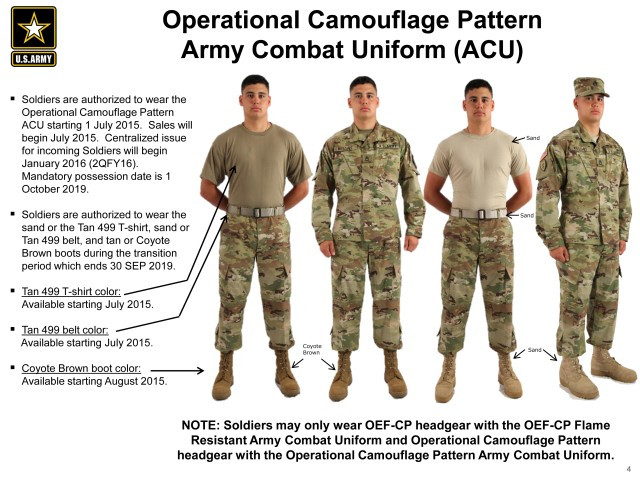The U.S. Army made a significant shift in its military apparel with the introduction of the Operational Camouflage Pattern (OCP). Announced in June 2015, this new camouflage design marked a pivotal update to the Army Combat Uniform (ACU), emphasizing improved soldier concealment and operational effectiveness. Starting July 1, 2015, soldiers began to see the Operational Camouflage Pattern available for purchase at military clothing sales stores, signaling the beginning of a phased transition.
 Soldiers in Operational Camouflage Pattern Army Combat Uniforms displaying the new pattern's effectiveness
Soldiers in Operational Camouflage Pattern Army Combat Uniforms displaying the new pattern's effectiveness
The rollout of the OCP uniforms was strategically planned over six months, from July to November, ensuring stores were adequately stocked. By January 2016, new recruits were issued the Operational Camouflage Pattern ACUs as standard gear. This transition followed the Army’s most thorough camouflage testing program, underscoring the importance of force protection and optimized camouflage in diverse operational environments. The selection of the Operational Camouflage Pattern was a direct result of the Army’s commitment to providing soldiers with the best possible equipment for mission success and safety.
Sgt. Maj. of the Army Daniel A. Dailey played a key role in guiding soldiers through this uniform update. He advised enlisted personnel to utilize their annual clothing allowance for purchasing the new OCP uniforms. This approach allowed soldiers to manage the cost effectively, integrating the uniform upgrade into their regular clothing allowance cycle over the subsequent 2-3 years. The Army aimed to minimize financial burden on soldiers during this transition, ensuring they could adopt the updated uniform without personal financial strain.
 Close-up of the Operational Camouflage Pattern fabric showcasing its multi-terrain effectiveness
Close-up of the Operational Camouflage Pattern fabric showcasing its multi-terrain effectiveness
Financially, the Operational Camouflage Pattern uniforms were priced similarly to the preceding Universal Camouflage Pattern (UCP) uniforms. This price parity was crucial in facilitating a smooth transition, as enlisted soldiers continued to receive their clothing allowance to replace worn uniforms, now including the option for the enhanced OCP design. This consistent cost structure ensured affordability and accessibility for all soldiers needing to update their gear.
Expanding availability, the Operational Camouflage Pattern uniforms and equipment were extended to the U.S. Army National Guard, U.S. Army Reserve, and Senior Reserve Officer Training Corps by the summer of 2016. This broader distribution ensured that all components of the Army benefited from the improved camouflage technology, standardizing the uniform across different Army branches and training programs.
To manage the transition practically, the Army authorized a mix-and-match approach for T-shirts, belts, and boots. Soldiers were permitted to wear items in either the Operation Enduring Freedom Camouflage Pattern (OEF-CP) or the Operational Camouflage Pattern during a transition period that extended until Oct. 1, 2019. Furthermore, soldiers already equipped with Flame Resistant ACUs in the OEF-CP were allowed to continue wearing them throughout this period, easing the immediate need for a complete uniform overhaul.
 Soldiers wearing the Operational Camouflage Pattern uniform in a field environment demonstrating camouflage performance
Soldiers wearing the Operational Camouflage Pattern uniform in a field environment demonstrating camouflage performance
Sgt. Maj. Dailey emphasized the role of noncommissioned officers in ensuring soldiers understood the authorized uniform variations during the transition. While maintaining a professional appearance remained a priority, the Army prioritized avoiding inconvenience or burden for its troops. The message was clear: operational effectiveness and soldier well-being were paramount, even during a period of uniform change.
Beyond just the camouflage pattern, the Operational Camouflage Pattern ACUs incorporated several design enhancements. These included redesigned shoulder sleeve pockets now featuring zipper closures for better security, the removal of the trouser drawstring for improved comfort and streamlined design, and the addition of a button on the lower calf pocket for enhanced functionality. Other changes included reducing pen pockets on the sleeve from three to two and eliminating the hook and loop patches on elbow and knee reinforcements, reflecting a focus on practical improvements based on soldier feedback and field experience.
 Detailed view of the Operational Camouflage Pattern ACU design features including zippered pockets and pen holders
Detailed view of the Operational Camouflage Pattern ACU design features including zippered pockets and pen holders
In conclusion, the adoption of the Operational Camouflage Pattern represents a significant advancement in U.S. Army uniforms. This change not only provided soldiers with a more effective camouflage solution for diverse operational theaters but also incorporated practical design improvements to enhance the functionality and wearability of the Army Combat Uniform. The carefully managed transition and focus on soldier needs underscored the Army’s commitment to equipping its personnel with the best possible resources for mission success and safety.
